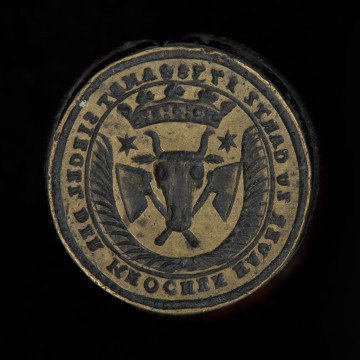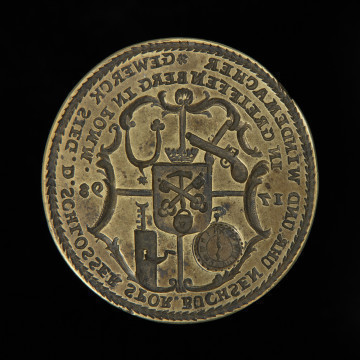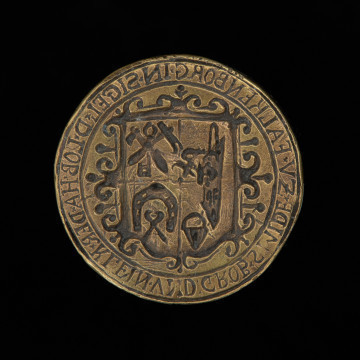
Stamp piston
1738
National Museum in Szczecin
Part of the collection: Seals of Pomeranian guilds
The guild seals of the needle makers prominently feature needles and fishing hooks – an example of this is the seal of Anklam needle makers of 1632. The seal was made with particular attention to detail. It features an late Renaissance escutcheon, with a vertical needle and crossed fishing hooks on it. The escutcheon features hachuring – a technique used in heraldry, used to render the colours of a coat of arms using dots or lines. In this case, the engraver used dots, which means that they wanted to represent the golden colour of the escutcheon. The engraver also took care of the precise execution of the surrounding inscription. The bronze working part of the seal was welded to a metal handle, which is flared at the top. It resembles a piece of minting equipment struck with a hammer. This allows us to think that the seal was not only used for making imprints in wax, but it could also have functioned as a so-called dry seal, imprinted on paper or on paper combined with wax or wafer. The seal of the Anklam needle makers guild is an example of using heraldry in the guild seal. The use of an escutcheon, hachuring and the specific arrangement of the elements were intended to make the guild seal a kind of a coat of arms, with a laurel wreath running along its edge.
Mieszko Pawłowski
Other names
Bronzener Siegelstempel
Author / creator
Dimensions
cały obiekt: height: 84.6 mm
Object type
seal
Technique
forging, fine detail finishing, punching, carving, soldering
Material
bronze, iron
Creation time / dating
Creation / finding place
Owner
National Museum in Szczecin
Identification number
Location / status

1738
National Museum in Szczecin

1798
National Museum in Szczecin

koniec XVII wieku
National Museum in Szczecin
DISCOVER this TOPIC
National Museum in Lublin
DISCOVER this PATH
Educational path